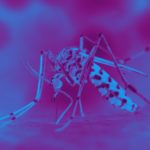Link to Pubmed [PMID] – 21798055
Parasit Vectors 2011 Jul;4:153
BACKGROUND: Intensive anti-malaria campaigns targeting the Anopheles population have demonstrated substantial reductions in adult mosquito density. Understanding the population dynamics of Anopheles mosquitoes throughout their whole lifecycle is important to assess the likely impact of vector control interventions alone and in combination as well as to aid the design of novel interventions.
METHODS: An ecological model of Anopheles gambiae sensu lato populations incorporating a rainfall-dependent carrying capacity and density-dependent regulation of mosquito larvae in breeding sites is developed. The model is fitted to adult mosquito catch and rainfall data from 8 villages in the Garki District of Nigeria (the ‘Garki Project’) using Bayesian Markov Chain Monte Carlo methods and prior estimates of parameters derived from the literature. The model is used to compare the impact of vector control interventions directed against adult mosquito stages–long-lasting insecticide treated nets (LLIN), indoor residual spraying (IRS)– and directed against aquatic mosquito stages, alone and in combination on adult mosquito density.
RESULTS: A model in which density-dependent regulation occurs in the larval stages via a linear association between larval density and larval death rates provided a good fit to seasonal adult mosquito catches. The effective mosquito reproduction number in the presence of density-dependent regulation is dependent on seasonal rainfall patterns and peaks at the start of the rainy season. In addition to killing adult mosquitoes during the extrinsic incubation period, LLINs and IRS also result in less eggs being oviposited in breeding sites leading to further reductions in adult mosquito density. Combining interventions such as the application of larvicidal or pupacidal agents that target the aquatic stages of the mosquito lifecycle with LLINs or IRS can lead to substantial reductions in adult mosquito density.
CONCLUSIONS: Density-dependent regulation of anopheline larvae in breeding sites ensures robust, stable mosquito populations that can persist in the face of intensive vector control interventions. Selecting combinations of interventions that target different stages in the vector’s lifecycle will result in maximum reductions in mosquito density.

